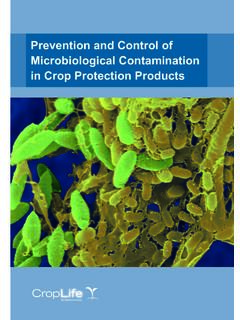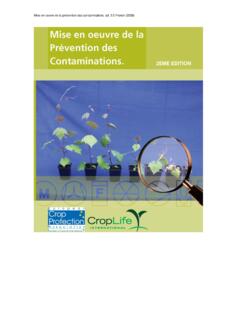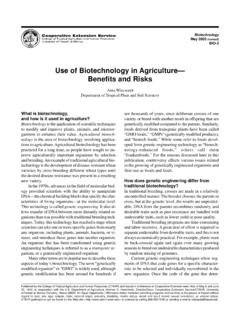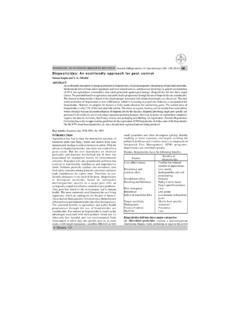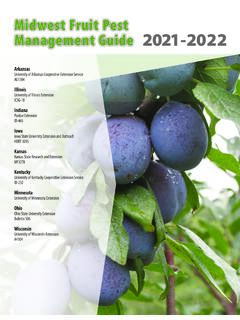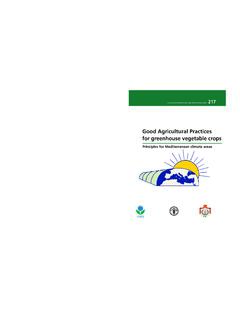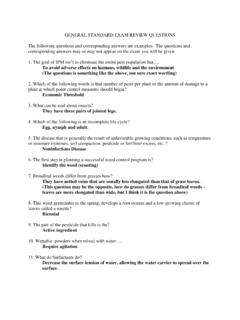Transcription of Integrated Pest Management - CropLife International
1 1 Integrated Pest Management2 CropLife International Policy on IPMOVERVIEW 3 What is IPM? 4 Why is IPM Important? 5 Benefits of IPMIPM COMPONENTS 5 Overview6 Prevention8 Monitoring8 InterventionIPM STRATEGIES AND TOOLS 10 Overview11 Setting an Economic Threshold11 Protecting Natural Enemies12 Selecting the Right Products12 Using Products Responsibly and Safely13 Preventing Pest Resistance to Crop Protection ProductsPLANT SCIENCE INDUSTRY AND IPM 14 Overview15 Stewardship and TrainingCASE STUDIES 16 Thailand Boosts Fruit Exports with IPM 17 Guatemala Pioneers Responsible Use Training 17 West Africa Protects Cocoa with Spray
2 Service18 Indian Farmers Benefit from IPM Training19 Europe Helps Protect Farmers and Public HealthTABLE OF CONTENTSCROPLIFE International POLICY ON IPM CropLife International and its member companies and associations support sustainable agriculture to produce sufficient, affordable food and fiber in an environmentally and socially sensitive manner. Our goal is to maintain the natural resource base for future are committed to Integrated Pest Management (IPM) an economically viable, environmentally sound and socially acceptable approach to crop protection as defined by the International Code of Conduct on Pesticide Management .
3 It is the mission of our member companies to provide customers with safe and effective technologies to protect against adverse effects caused by pests, diseases and weeds. Our member companies enable and encourage the implementation of IPM by developing and promoting appropriate products and services. We cooperate with partners to develop and test IPM strategies and programs as well as provide education and training on the sustainable use of crop protection products. We measure and communicate progress within our industry on the adoption of the principles and values of this is IPM?
4 According to the Food and agriculture Organization (FAO) of the United Nations*, IPM means considering all available pest control techniques and other measures that discourage the development of pest populations, while minimizing risks to human health and the environment. For farmers, IPM is the best combination of cultural, biological and chemical measures to manage diseases, insects, weeds and other pests. It takes into account all relevant control tactics and methods that are locally available, evaluating their potential cost-effectiveness. IPM does not, however, consist of any absolute or rigid criteria.
5 It is a flexible system that makes good use of local resources and the latest research, technology, knowledge and experience. Ultimately, IPM is a site-specific strategy for managing pests in the most cost-effective, environmentally sound and socially acceptable way. Implementation of IPM lies with farmers, who adopt practices they view as practical and valuable to their allows farmers to manage diseases, insects, weeds and other pests in a cost-effiective and environmentally sound way.* Integrated Pest Management (IPM) means the careful consideration of all available pest control techniques and subsequent integration of appropriate measures that discourage the development of pest populations and keep pesticides and other interventions to levels that are economically justified and reduce or minimize risks to human health and the environment.
6 IPM emphasizes the growth of a healthy crop with the least possible disruption to agro-ecosystems and encourages natural pest control mechanisms. (FAO, 2012).4 Why is IPM Important?The demands of a growing world population for food and fiber require farmers to produce more crops on existing farmland. To increase these yields requires continuous improvement of agricultural technologies to minimize crop losses. The challenge is to do this while protecting the environment. IPM is a big part of the solution. Increasingly it is being adopted in both developed and developing countries for long-term, sustainable agriculture that achieves adequate, safe and quality food production, improves farmer livelihoods and conserves non-renewable resources.
7 Sustainably MAXIMIZE PRODUCTIONand due to insects, weeds and diseases MINIMIZE LOSSESTHIS MEANS FARMERS MUST on existing landINCREASEYIELDS and looking after the environmentwhile PROTECTING BIODIVERSITY FOOD DEMAND and therefore so isGLOBALPOPULATIONis on the rise IPM PROVIDES FARMERS WITH TOOLS AND STRATEGIES TOsustainably MAXIMIZE PRODUCTIONand due to insects, weeds and diseases MINIMIZE LOSSESTHIS MEANS FARMERS MUST on existing landINCREASEYIELDS and looking after the environmentwhile PROTECTING BIODIVERSITY FOOD DEMAND and therefore so isGLOBALPOPULATIONis on the rise IPM PROVIDES FARMERS WITH TOOLS AND STRATEGIES TOsustainably MAXIMIZE PRODUCTIONand due to insects.
8 Weeds and diseases MINIMIZE LOSSESTHIS MEANS FARMERS MUST on existing landINCREASEYIELDS and looking after the environmentwhile PROTECTING BIODIVERSITY FOOD DEMAND and therefore so isGLOBALPOPULATIONis on the rise IPM PROVIDES FARMERS WITH TOOLS AND STRATEGIES TOsustainably MAXIMIZE PRODUCTIONand due to insects, weeds and diseases MINIMIZE LOSSESTHIS MEANS FARMERS MUST on existing landINCREASEYIELDS and looking after the environmentwhile PROTECTING BIODIVERSITY FOOD DEMAND and therefore so isGLOBALPOPULATIONis on the rise IPM PROVIDES FARMERS WITH TOOLS AND STRATEGIES TOsustainably MAXIMIZE PRODUCTIONand due to insects.
9 Weeds and diseases MINIMIZE LOSSESTHIS MEANS FARMERS MUST on existing landINCREASEYIELDS and looking after the environmentwhile PROTECTING BIODIVERSITY FOOD DEMAND and therefore so isGLOBALPOPULATIONis on the rise IPM PROVIDES FARMERS WITH TOOLS AND STRATEGIES TOsustainably MAXIMIZE PRODUCTIONand due to insects, weeds and diseases MINIMIZE LOSSESTHIS MEANS FARMERS MUST on existing landINCREASEYIELDS and looking after the environmentwhile PROTECTING BIODIVERSITY FOOD DEMAND and therefore so isGLOBALPOPULATIONis on the rise IPM PROVIDES FARMERS WITH TOOLS AND STRATEGIES TOsustainably MAXIMIZE PRODUCTIONand due to insects.
10 Weeds and diseases MINIMIZE LOSSESTHIS MEANS FARMERS MUST on existing landINCREASEYIELDS and looking after the environmentwhile PROTECTING BIODIVERSITY FOOD DEMAND and therefore so isGLOBALPOPULATIONis on the rise IPM PROVIDES FARMERS WITH TOOLS AND STRATEGIES TOsustainably MAXIMIZE PRODUCTIONand due to insects, weeds and diseases MINIMIZE LOSSESTHIS MEANS FARMERS MUST on existing landINCREASEYIELDS and looking after the environmentwhile PROTECTING BIODIVERSITY FOOD DEMAND and therefore so isGLOBALPOPULATIONis on the rise IPM PROVIDES FARMERS WITH TOOLS AND STRATEGIES TOsustainably MAXIMIZE PRODUCTIONand due to insects.

